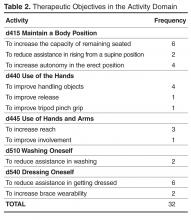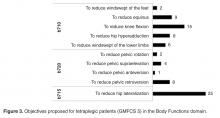Results
The mean age of the children was 12 years; 42% were female and 58% were male. The diplegic type made up 38% of CP cases, the tetraplegic type 35%, and the hemiplegic type 24%. GMFCS distribution was as follows: Level 1 (mildest), 39%; Level 2, 11%; Level 3, 9%; Level 4, 25%; and Level 5, 26%. Among the 188 children with CP, a total of 278 objectives were identified. 88% (246) of these objectives were in the “Body Functions” domain, distributed among 6 ICF categories ( Table 1) . Thirty-two objectives fell under the “Activity” domain, distributed among 5 ICF categories ( Table 2 ).Body Functions Domain
The most represented category in the “Body Functions” domain was “b770 functions of gait pattern” (50%). There were 123 proposed objectives distributed among 11 typologies of objectives for a total of 123 proposed objectives in the functions of gait pattern category.
The most frequent proposals were aimed at the reduction of equinus in the stance phase ( n = 44) and reduce knee flexion in load ( n = 17). The second most represented category was “b710 functions of joint mobility” (26%), in which 7 typologies of objectives were identified for a total of 64 objectives proposed, which were principally aimed at controlling joint deformities (Table 1).In the “b715 functions of joint stability” category, 25 objectives were proposed for controlling hip lateralization while, in the “b720 functions of bone mobility” category, 4 typologies of objectives were identified out of a total of 15 proposed objectives aimed at improving the position of the pelvis. The “b280 pain sensation” category was also used to indicate 15 objectives aiming at alleviating knee, hip and spinal column pain. Finally, 4 objectives were aimed at tone reduction.
Activity Domain
As concerns the “Activity” domain, 38% of objectives were classified into the “d415 maintain body position” category (3 typologies and a total of 12 proposals), 25% were in the “d540 dress oneself ” category (2 typologies and a total of 8 proposals), 19% were in the “d440 fine use of the hands” category (3 typologies and a total of 6 proposals), 13% were in the “d445 use of hands and arms” category (2 typologies and 4 proposals) and, 6% of cases were classified into the “d510 wash oneself” category (2 proposals) (Table 2).





